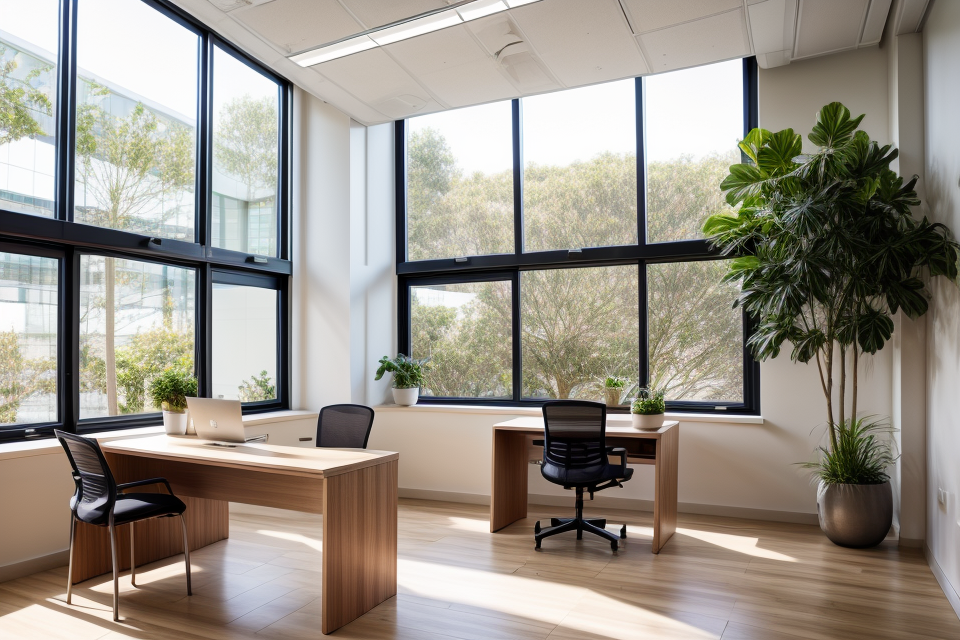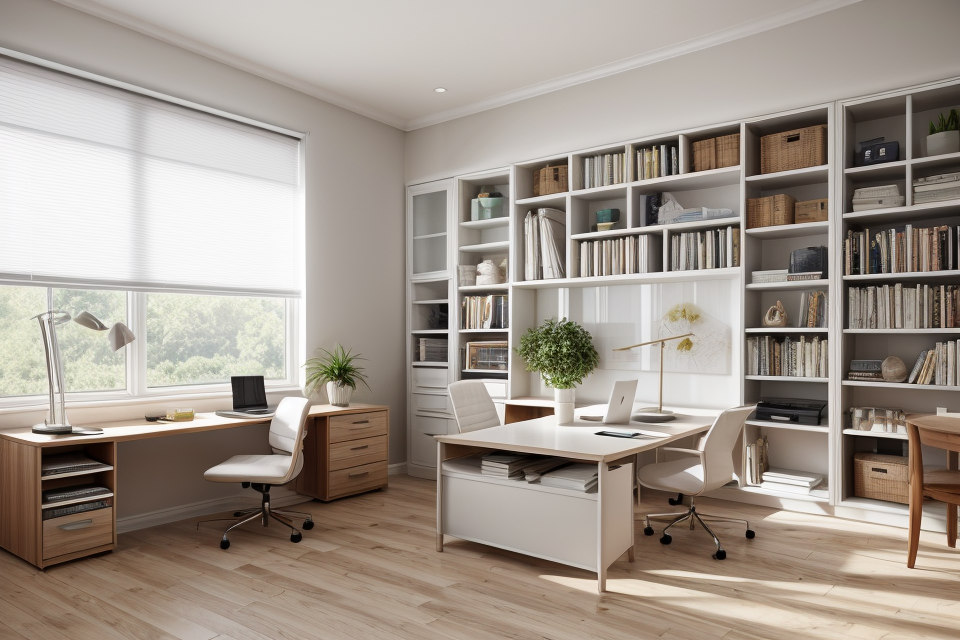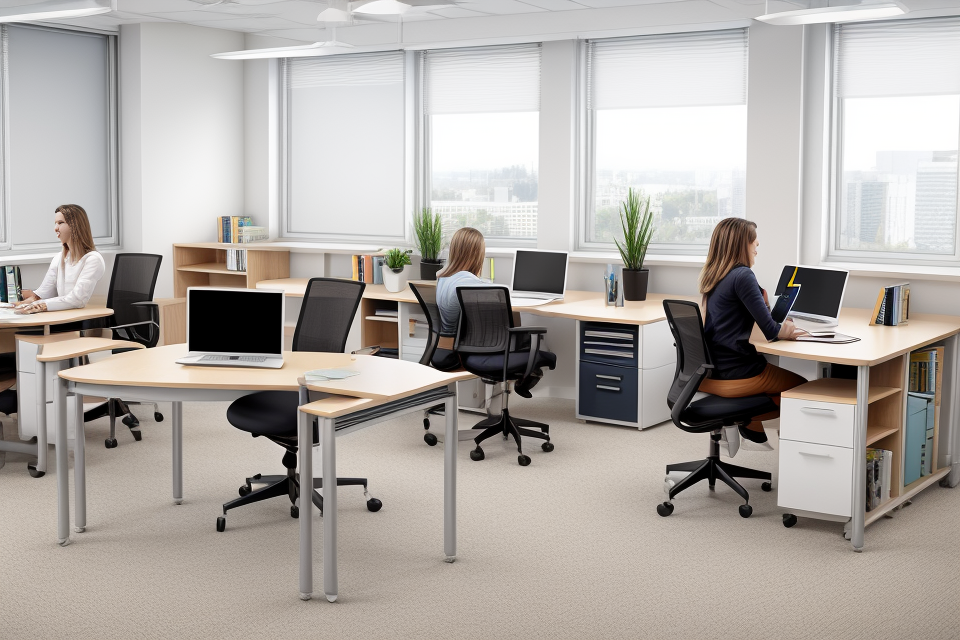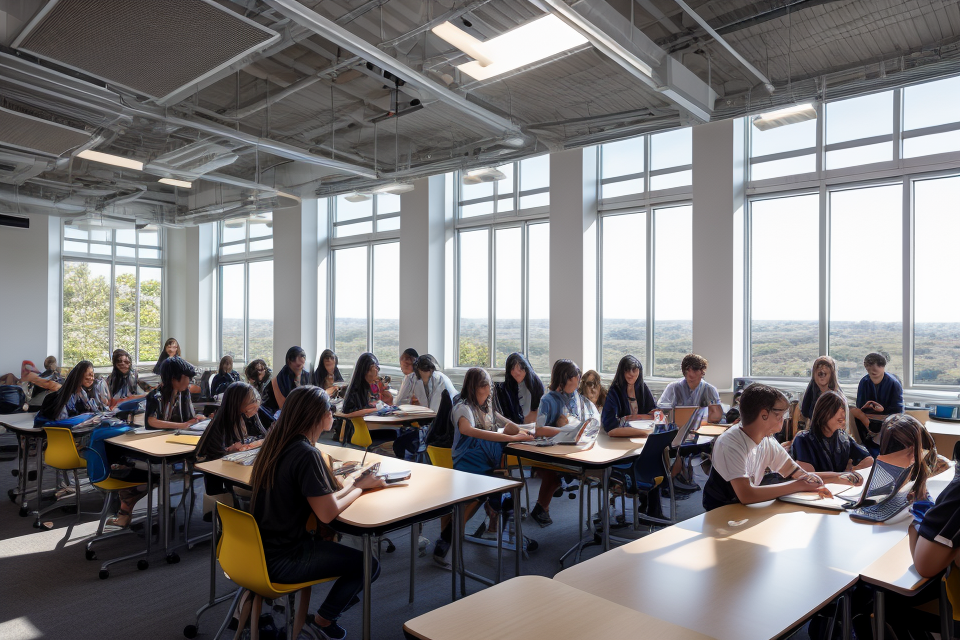
Creating the perfect learning environment is a crucial aspect of ensuring that students receive the best education possible. A well-optimized learning environment can enhance the overall learning experience, improve student engagement, and promote academic success. In this article, we will explore some tips for optimizing a learning environment to create a dynamic and stimulating space that supports learning and development. From designing flexible classrooms to incorporating technology, these tips will help educators create an environment that fosters growth and achievement.
Factors Affecting Learning Environments
Physical Environment
The physical environment plays a crucial role in determining the effectiveness of a learning space. This section will explore the various factors that contribute to the optimal physical environment for learning.
Lighting
Lighting is a critical factor in creating the perfect learning environment. Natural light is preferred as it helps to boost alertness and productivity. However, excessive direct sunlight can cause glare and discomfort, so it is essential to strike a balance. Indoor lighting should be adequate and evenly distributed, avoiding harsh shadows and glare. Dimmable lights are also recommended as they allow for adjustments based on the time of day and the activity being performed.
Temperature
Temperature is another important factor to consider in a learning environment. The ideal temperature for learning is generally considered to be between 18-24°C (64-75°F). Temperatures that are too cold or too hot can lead to discomfort and distractions, impacting the ability to focus and learn effectively. It is also important to consider the season and ensure that the room is at a comfortable temperature for the individuals using it.
Noise levels
Noise levels can have a significant impact on the learning environment. Too much noise can be distracting and make it difficult to concentrate, while too little noise can make the space feel uninviting and dull. It is important to find a balance that allows for appropriate levels of background noise to help with concentration, while also providing quiet spaces for focused study.
Ergonomics
Ergonomics refers to the design of the physical space to ensure that it is comfortable and safe for individuals to use. This includes factors such as seating, desks, and computer equipment. Chairs should be comfortable and provide adequate support for the back, while desks should be at a comfortable height and provide enough space for materials and equipment. Additionally, ensuring that computer equipment is ergonomically designed can help to reduce the risk of injury and discomfort during prolonged use.
Psychological Environment
The psychological environment plays a crucial role in shaping the learning experience. It encompasses various factors that can either facilitate or hinder the learning process. Understanding these factors can help optimize the learning environment and enhance overall performance.
- Motivation: Motivation is a driving force that stimulates learning and enhances engagement. It can be intrinsic, such as the joy of learning or curiosity, or extrinsic, such as rewards or recognition. To optimize motivation, it is essential to identify individual learners’ needs and preferences, provide clear goals and feedback, and create a supportive atmosphere that fosters a sense of accomplishment.
- Attention: Attention is the cognitive process that enables learners to focus on relevant information and filter out distractions. To optimize attention, it is important to create a conducive environment that minimizes distractions, manage information overload, and use strategies such as breaking tasks into smaller steps, providing regular breaks, and using multimedia to capture learners’ attention.
- Memory: Memory is the cognitive system responsible for encoding, storing, and retrieving information. To optimize memory, it is important to understand individual learners’ memory capabilities, use effective mnemonic devices, provide regular practice and repetition, and create a learning environment that supports consolidation and retrieval of information.
- Emotions: Emotions play a significant role in the learning process, as they can influence motivation, attention, and memory. To optimize emotions, it is important to create a supportive and positive learning environment, encourage self-reflection and self-regulation, and provide opportunities for learners to develop emotional intelligence and resilience.
Assessing Your Current Learning Environment
Self-Assessment Checklist
Creating the perfect learning environment requires self-assessment of your current learning environment. Here is a checklist to help you assess your current learning environment:
- Noise level: The noise level in your learning environment can have a significant impact on your ability to concentrate and learn. High levels of noise can be distracting and disruptive to your learning process. On the other hand, too little noise can make it difficult to focus and stay alert. Therefore, it is essential to find a balance when it comes to noise level. Ideally, the noise level should be low to moderate, with no sudden or unexpected sounds that can disrupt your concentration.
- Lighting: Lighting is another critical factor to consider when assessing your learning environment. The lighting should be adequate, comfortable, and well-distributed throughout the learning area. Poor lighting can cause eye strain, headaches, and fatigue, which can negatively impact your ability to learn. Natural light is generally the best type of lighting for learning, but if natural light is not available, consider using full-spectrum light bulbs or other types of lighting that mimic natural light.
- Temperature: The temperature of your learning environment can also impact your ability to learn. Ideally, the temperature should be comfortable and conducive to learning. This means that the temperature should be neither too hot nor too cold. The ideal temperature range is between 60 and 68 degrees Fahrenheit. If the temperature is too hot or too cold, it can be distracting and disruptive to your learning process.
- Comfortable seating: Comfortable seating is crucial when it comes to creating the perfect learning environment. The seating should be comfortable, supportive, and ergonomic. Uncomfortable seating can cause discomfort, pain, and fatigue, which can negatively impact your ability to learn. Ideally, the seating should be adjustable and able to support different body types and positions.
- Minimal distractions: Minimal distractions are also essential when it comes to creating the perfect learning environment. Distractions can come in many forms, such as noise, light, temperature, and even the layout of the learning environment. To minimize distractions, it is essential to create a learning environment that is conducive to concentration and focus. This may involve removing unnecessary items from the learning environment, organizing the learning area in a way that minimizes distractions, and minimizing interruptions from other people or technology.
Environmental Audit
Assessing your current learning environment is the first step towards optimizing it. One way to do this is by conducting an environmental audit. Here’s how:
Observe and Document the Physical Environment
The physical environment plays a crucial role in your learning experience. Take note of the lighting, temperature, noise level, and overall cleanliness of your study space. Make sure to document any issues or areas that need improvement.
Survey Peers for Their Opinions
Your peers can provide valuable insights into your learning environment. Ask them for their opinions on your study space, including what they think works well and what could be improved. This can help you identify blind spots and get a fresh perspective on your learning environment.
Evaluate Personal and Environmental Factors
Your personal preferences and environmental factors can also impact your learning experience. Consider your preferred learning style, the time of day you are most productive, and any allergies or sensitivities you may have. Additionally, take into account any distractions in your environment, such as social media or noise, and how they may affect your focus.
By conducting an environmental audit, you can gain a better understanding of your current learning environment and identify areas for improvement. This will help you create a more optimal learning environment that supports your academic goals.
Strategies for Optimizing Your Learning Environment
Goal Setting
When it comes to creating the perfect learning environment, goal setting is a crucial component. Goal setting involves defining specific, measurable, achievable, relevant, and time-bound (SMART) objectives that you want to achieve in your learning process. Here are some tips to help you set effective goals for your learning environment:
- Define specific, measurable, achievable, relevant, and time-bound (SMART) goals: SMART goals are specific, measurable, achievable, relevant, and time-bound. By setting SMART goals, you can create a clear roadmap for your learning process and measure your progress along the way. For example, instead of setting a vague goal like “I want to learn more,” you could set a SMART goal like “I want to learn the basics of Python programming within the next three months.”
- Set short-term and long-term goals: It’s important to set both short-term and long-term goals for your learning process. Short-term goals are smaller, more immediate objectives that help you stay motivated and on track. Long-term goals are bigger, more ambitious objectives that require sustained effort and commitment over a longer period of time. For example, a short-term goal might be to complete a specific chapter in a textbook, while a long-term goal might be to earn a degree or certification in a particular field.
By setting specific, measurable, achievable, relevant, and time-bound (SMART) goals and balancing short-term and long-term objectives, you can create a roadmap for your learning process that is both realistic and achievable.
Time Management
Schedule study sessions in advance
To optimize your learning environment, it is crucial to plan your study sessions in advance. By creating a schedule, you can allocate specific times for studying and ensure that you have enough time to cover all the material. This approach also helps you prioritize your studies and make time for other important activities.
Allocate time for breaks and leisure activities
Taking breaks and engaging in leisure activities are essential for maintaining focus and avoiding burnout. Allocating specific times for breaks and leisure activities can help you recharge and maintain a healthy work-life balance. This approach can also improve your overall well-being and increase your productivity.
Minimize multitasking
Multitasking can be detrimental to your learning environment. It can lead to decreased productivity, increased stress, and reduced concentration. To optimize your learning environment, it is essential to minimize multitasking and focus on one task at a time. This approach can help you stay focused, reduce stress, and improve your overall learning outcomes.
Focus Techniques
When it comes to optimizing your learning environment, one of the most important aspects is maintaining focus. Without a clear and unwavering concentration, it can be difficult to absorb and retain information. Here are some effective techniques for enhancing your focus and improving your overall learning experience:
The Pomodoro Technique
The Pomodoro Technique is a time management method that involves breaking your study sessions into short, focused intervals. The idea is to work for a set period of time (usually 25 minutes) followed by a short break. After completing four Pomodoro cycles, you take a longer break. This technique has been shown to improve productivity and reduce mental fatigue.
To implement the Pomodoro Technique, follow these steps:
- Choose a task you want to work on.
- Set a timer for 25 minutes and commit to working on that task during that time.
- Avoid distractions during the focused interval.
- Take a short break (5-10 minutes) after completing the Pomodoro cycle.
- Repeat the process until you have completed the desired amount of work.
Mindfulness Meditation
Mindfulness meditation is a practice that involves focusing your attention on the present moment without judgment. This technique has been shown to improve cognitive function, increase self-awareness, and reduce stress.
To practice mindfulness meditation, follow these steps:
- Find a quiet, comfortable place to sit or lie down.
- Close your eyes and focus on your breath.
- When your mind wanders, gently redirect your focus back to your breath.
- Try to stay in this state of mindfulness for a few minutes, gradually increasing the time as you become more comfortable with the practice.
Guided Imagery
Guided imagery is a technique that involves using mental images to achieve a specific goal, such as enhancing focus or reducing anxiety. This practice can help you relax and reduce distractions, making it easier to concentrate on your studies.
To practice guided imagery, follow these steps:
- Close your eyes and focus on a peaceful image, such as a beach or a forest.
- Imagine yourself in this environment, feeling calm and relaxed.
- Slowly bring yourself back to the present moment, feeling refreshed and focused.
By incorporating these focus techniques into your learning environment, you can improve your ability to concentrate and absorb information. Experiment with different techniques to find what works best for you, and don’t be afraid to modify them to suit your needs.
Customizing Your Environment
- Organize study materials
- Sort study materials by subject or topic
- Keep study materials in labeled and designated areas
- Use storage solutions to keep materials organized and accessible
- Create a comfortable and personalized space
- Incorporate ergonomic furniture for proper posture and comfort
- Add personal touches to the space, such as artwork or plants
- Ensure adequate lighting for reading and writing
- Use visual cues to enhance focus
- Use color-coding to categorize materials and highlight important information
- Use sticky notes to remind yourself of key concepts or upcoming deadlines
- Use whiteboards or bulletin boards to map out ideas and create visual aids for studying
Implementing and Monitoring Progress
Evaluating Progress
Evaluating progress is a crucial step in the learning process, as it allows you to assess whether you are making progress towards your goals, and to make any necessary adjustments to your strategies. Here are some tips for evaluating progress effectively:
- Regularly review progress against set goals: It’s important to regularly review your progress against the goals you have set for yourself. This will help you to identify any areas where you may be falling short, and to make adjustments to your strategies as needed.
- Adjust strategies as needed: If you find that you are not making progress towards your goals, it may be necessary to adjust your strategies. This could involve changing the way you approach your learning, or seeking out additional resources or support.
- Seek feedback from peers or mentors: It can be helpful to seek feedback from others who are familiar with your learning process. This could include peers who are also working towards similar goals, or mentors who have experience in the area you are learning. They may be able to provide valuable insights and suggestions for improvement.
By regularly evaluating your progress and making adjustments as needed, you can ensure that you are on track to achieve your learning goals.
Continuous Improvement
In order to achieve a truly optimal learning environment, it is essential to embrace a mindset of continuous improvement. This involves consistently reflecting on what works and what doesn’t, remaining open to experimenting with new strategies, and adapting to changing circumstances and priorities. By continuously striving for improvement, learners can make the most of their environment and enhance their overall learning experience.
Reflecting on what works and what doesn’t
Regularly assessing the effectiveness of the current learning environment is crucial for identifying areas that require improvement. This can involve soliciting feedback from students, observing their behavior and interactions within the space, and analyzing data on their performance. By understanding what is working well and what is not, educators can make informed decisions about how to optimize the environment for improved learning outcomes.
Being open to experimenting with new strategies
In order to continuously improve the learning environment, it is important to remain open to trying new strategies and approaches. This might involve incorporating new technologies, adjusting the physical layout of the space, or introducing novel teaching methods. By being willing to experiment and take calculated risks, educators can uncover new ways to enhance the learning experience and create a more effective environment for students.
Adapting to changing circumstances and priorities
As circumstances and priorities evolve, it is important to adapt the learning environment accordingly. This might involve responding to changes in student needs, updating curriculum requirements, or addressing new challenges such as emerging technologies or global events. By remaining flexible and responsive to changing circumstances, educators can ensure that the learning environment remains optimized for student success.
By embracing a mindset of continuous improvement and actively seeking opportunities to enhance the learning environment, educators can create an optimal space for student success. Through regular reflection, experimentation, and adaptation, educators can ensure that their learning environments remain effective and supportive of student learning.
Recap of Key Points
- Physical and psychological factors affect learning environments: A learning environment that is both physically and psychologically conducive to learning can significantly enhance the learning experience.
- Assess your current learning environment: Conduct a thorough assessment of your current learning environment to identify areas for improvement. This includes evaluating factors such as lighting, temperature, noise levels, and distractions.
- Implement strategies for optimization: Implement strategies to optimize your learning environment. This may include adjusting the layout of your study space, incorporating natural light, using white noise machines, and reducing distractions.
- Monitor progress and continuously improve: Continuously monitor your progress and make adjustments as needed. This may involve periodically reassessing your learning environment and implementing new strategies to optimize it.
FAQs
1. What is a learning environment?
A learning environment refers to the physical and social surroundings in which learning takes place. It includes classrooms, libraries, laboratories, and other spaces where students receive instruction and engage in learning activities.
2. Why is it important to optimize a learning environment?
An optimized learning environment can improve student engagement, motivation, and learning outcomes. It can also support the development of critical thinking, problem-solving, and collaboration skills.
3. What are some tips for optimizing a learning environment?
a. Create a safe and inclusive atmosphere
A safe and inclusive atmosphere is essential for creating a positive learning environment. Teachers can establish ground rules for respectful communication, encourage diverse perspectives, and address any incidents of bullying or discrimination.
b. Provide adequate lighting and ventilation
Adequate lighting and ventilation are important for student comfort and concentration. Teachers can ensure that classrooms have sufficient natural light and adjustable lighting to accommodate different activities. They can also provide air circulation and temperature control to create a comfortable learning environment.
c. Use technology to enhance learning
Technology can be used to enhance learning by providing access to multimedia resources, interactive simulations, and online collaborative tools. Teachers can incorporate technology into their lessons and provide students with opportunities to use technology for research, communication, and problem-solving.
d. Encourage student participation and collaboration
Encouraging student participation and collaboration can create a more dynamic and engaging learning environment. Teachers can use cooperative learning strategies, group projects, and class discussions to foster student engagement and collaboration.
e. Create a clutter-free environment
A clutter-free environment can help students focus on learning activities. Teachers can organize classrooms and materials in a way that promotes cleanliness and order, and encourage students to keep their workspaces tidy.
f. Foster a growth mindset
Fostering a growth mindset can help students develop a positive attitude towards learning and perseverance in the face of challenges. Teachers can encourage students to embrace effort, persistence, and resilience as key factors in learning and achievement.
g. Provide opportunities for physical activity
Physical activity can improve student focus, energy levels, and overall well-being. Teachers can incorporate movement breaks, outdoor activities, or physical education classes into their lessons to promote physical activity and break up long periods of sitting.
4. How can teachers evaluate the effectiveness of a learning environment?
Teachers can evaluate the effectiveness of a learning environment by observing student engagement, participation, and learning outcomes. They can also collect feedback from students through surveys or discussions, and use assessment data to identify areas for improvement. Teachers can also seek feedback from colleagues and administrators to gain different perspectives on the learning environment.


